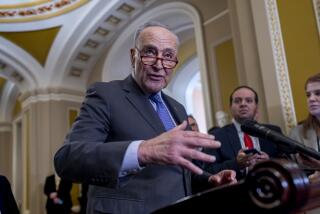Senate Endorses More Weeks of Daylight-Saving
- Share via
WASHINGTON — The Senate voted Tuesday to make daylight-saving time start three weeks earlier--handing a political victory to tennis enthusiasts, barbecuers and people who live on the eastern edges of time zones, including Californians.
It was a setback, however, for such diverse allies as operators of daytime AM radio stations, rural schoolchildren, farmers and residents of western ends of time zones. The measure passed on a voice vote after a procedural effort to set it aside failed.
The idea of permanently lengthening the period during which most states observe daylight-saving time has been considered on Capitol Hill for more than 10 years.
Bill’s Best Chance
Such legislation, which is supported by the Reagan Administration, has passed each house before. However, the Senate vote Tuesday marked the first time that it has passed both in a single session and, therefore, gave it the best chance it has ever had of ultimately becoming law.
A House-Senate conference committee still must work out a compromise between the Senate bill and the version that passed the House last October.
Under the Senate bill, daylight-saving time would begin three weeks earlier, on the first Sunday in April, rather than the last. The House measure would extend it four weeks by making the period last an additional week into the fall as well, to shed more light on Halloween trick-or-treaters. The House bill would have it end the first Sunday in November, rather than the last Sunday of October.
Sen. Slade Gorton (R-Wash.), who led the Senate fight for the measure, pointed out during two days of debate that daylight-saving time was designed to “correspond with the hours of the day during which most people are awake and active. . . . I believe that most Americans would rather have an hour of daylight in the early evening than in the early morning.”
What’s more, Gorton said, studies indicate that daylight is not the only thing saved by moving the clock forward: It could conserve up to 100,000 barrels of oil a day. Also, it is believed to reduce violent crime and make driving safer.
But Sen. Wendell H. Ford (D-Ky.), the chief opponent, dismissed such arguments: “Any Kentucky mother who has sent a first-grader out to catch a bus on a dark, misty April morning takes a dim view about the importance of electricity that might be saved on the East and West coasts and the number of after-work tennis games that might be played here in Washington, D.C.”
He also said that extending daylight-saving time would further disadvantage farmers and other early-risers in such states as Kentucky, which are on the western edges of time zones and already must wait longer for sunrise than their counterparts on the eastern ends of zones. Similarly, he said, the nation’s 450 radio stations with licenses that do not allow pre-sunrise operations would miss an hour of broadcasting during lucrative morning drive time.
The nation experimented briefly with year-round daylight-saving time to conserve energy during the fuel crisis of the mid-1970s. However, the move generated widespread complaints about having motorists on the road and schoolchildren waiting for buses in the icy, pre-dawn darkness of winter.
Proponents of extending it gathered the votes they needed for passage after they scaled back their initial proposal to have daylight-saving time begin in March.
The House and Senate bills retain a provision of existing law that allows states and territories to choose to keep standard time all year. Those that have done that are Arizona, Hawaii, Puerto Rico, the Virgin Islands, American Samoa and the portion of Indiana that lies in the Eastern time zone.
More to Read
Get the L.A. Times Politics newsletter
Deeply reported insights into legislation, politics and policy from Sacramento, Washington and beyond. In your inbox twice per week.
You may occasionally receive promotional content from the Los Angeles Times.










